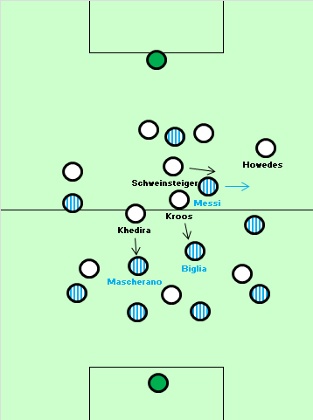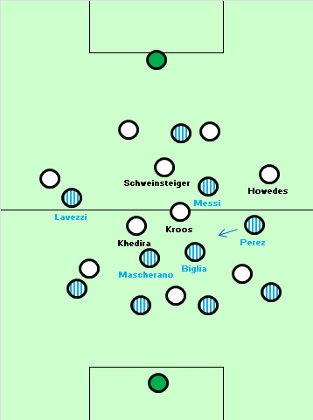Germany will need to deal with the threat of Lionel Messi, while Argentina have to overcome passing weakness in midfield.
How do Germany stop Messi?
Germany kept Lionel Messi quiet in their 4-0 thrashing of Argentina in the 2010 quarter-final, but it will be a tougher task this time around. Messi is now more comfortable in that classic Argentinian No10 role, and has shown patience and guile when receiving the ball in deeper positions.
The man tasked with stopping Messi will be Bastian Schweinsteiger, who has played the deep-lying midfield role since Joachim Löw reformatted his side for the 1-0 quarter-final victory over France. The Bayern midfielder is an excellent passer, but can struggle defensively against tricky, top-class opponents, and the composition of Germany’s midfield triangle means Toni Kroos and Sami Khedira are likely to be pressing Argentina’s deep midfielders, rather than helping to stop Messi.
A further concern is the suspicion Messi will drift out to the right, as he did frequently in the semi-final against Holland. In that zone, he’ll be up against Germany’s weak link Benedikt Höwedes, although as a natural, right-footed centre-back, Höwedes might defend narrowly and show Messi down the outside, which is preferable to letting him inside on to his left foot.
Germany need three things to go right to prevent Messi dominating. First, they need a good individual performance from Schweinsteiger, handed the most difficult task of his career: stopping the most celebrated player of his generation performing on the world’s biggest stage.
More crucially, they need a good team effort. This means the second task must be to remain extremely compact, denying Messi space between the lines, and getting bodies around him if he manages to evade Schweinsteiger.
Third, they must attempt to prevent the service into him. Kroos and Khedira pressed Brazil’s deep midfielders excellently in the staggering 7-1 semi-final victory over the hosts, and they’ll look to shut down Javier Mascherano and Lucas Biglia similarly.

How do Argentina cope in midfield?
Argentina will be determined not to suffer the same problems as Brazil, who were pressed into submission by the energy and tenacity of the German midfield. This will be extremely tough for Argentina, who aren’t blessed with great passers in the centre of the pitch, especially with one day less rest.
Alejandro Sabella is likely to continue with Enzo Pérez on one flank, probably the right, in place of the injured Ãngel di MarÃa. The Benfica winger isn’t anything like a natural replacement, however, and more of a central midfielder – he’ll tuck inside and play alongside Javier Mascherano and Lucas Biglia, with Argentina hoping to win the midfield battle with quantity, rather than quality. Sabella will be happy for Pérez to concentrate his efforts in the centre of the pitch rather than out wide – the German left-back Höwedes can be allowed freedom, as he’s unlikely to cause attacking problems.
Argentina’s central midfielders must offload the ball quickly when pressed – they only need to watch a video of the Brazilian midfielder Fernandinho dallying in possession for Germany’s fourth goal to realise the outcome of such errors. While Mascherano has impressed with his tenacious tackling, his distribution has also been excellent at this World Cup, and since moving to Barcelona he has passed the ball much more swiftly.
Maybe the ultimate answer to the threat of Germany’s midfield, however, is simply defending deep. Germany don’t depend upon counter-attacking as much as in 2010, but their most dangerous attacks against Brazil were quick, direct and about breaking into space. When Argentina get numbers behind the ball, they’re extremely solid, and they’re yet to concede a goal in the knockout stage of this competition. Rather than trying to compete in midfield, Sabella might allow Germany the run of that zone, and keep it tight much deeper.

guardian.co.uk © Guardian News & Media Limited 2010
Published via the Guardian News Feed plugin for WordPress.
